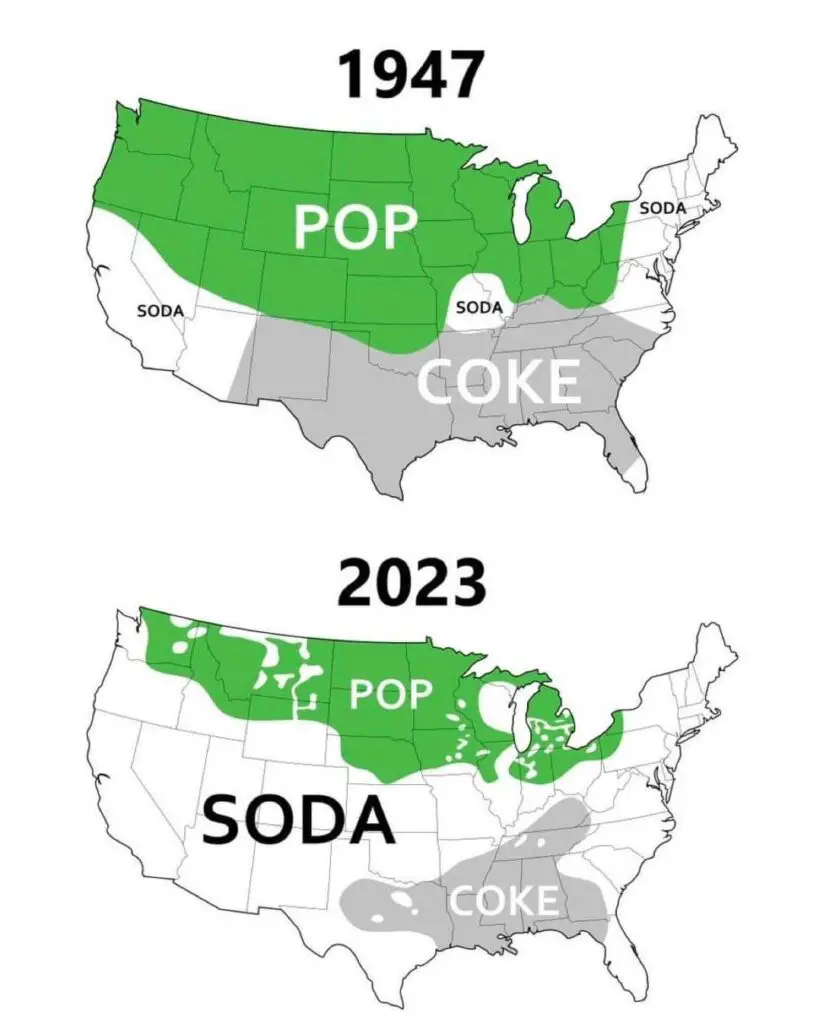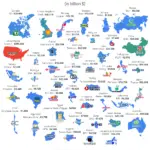Soda vs. coke vs. pop
Soft drinks, also known as sodas or carbonated beverages, are non-alcoholic, effervescent beverages typically flavored with sweeteners. Common ingredients include carbonated water, high-fructose corn syrup or artificial sweeteners, flavorings, and, in some cases, caffeine.
In the United States, soft drinks have long been a pervasive element of beverage consumption, deeply ingrained in the nation’s culture. Colloquially known as sodas or pop, these carbonated beverages are available in a diverse array of flavors and brands. The dominant players in the U.S. soft drink market include well-established names like Coca-Cola and PepsiCo. The popularity of these drinks is evident in their ubiquitous presence, from family picnics to fast-food restaurants. However, the industry has witnessed notable shifts in recent years, with an increasing emphasis on healthier alternatives, such as sparkling water and natural fruit beverages, in response to growing health consciousness among consumers. Additionally, concerns about the environmental impact of single-use plastic bottles have prompted discussions about sustainability, influencing beverage packaging choices. Despite these evolving trends, soft drinks remain a significant part of American beverage culture, reflecting both tradition and the ongoing adaptation to changing consumer preferences and societal concerns.
In the United States, soft drinks are often referred to as sodas, colas, or pops.
The choice of terms such as “soda,” “coke,” or “pop” to describe carbonated beverages in the United States is intricately tied to regional linguistic patterns and cultural influences. These variations reflect a rich tapestry of historical and social factors, shaping language preferences across different parts of the country.
Soda
The term “soda” is commonly used on the East and West Coasts of the United States. This preference is often linked to the historical influx of immigrants from European countries, where “soda” was a more prevalent term for carbonated beverages. Over time, this linguistic tradition has persisted, and residents of coastal areas continue to refer to soft drinks as “soda.”
Coke
In the southern United States, particularly in states like Texas and the Southeast, people frequently use “Coke” as a generic term for any carbonated beverage, regardless of the actual brand. This phenomenon can be attributed to the strong influence of the Coca-Cola Company, which is headquartered in Atlanta, Georgia. The company’s pervasive presence in the region has led to the widespread use of “Coke” as a catch-all term.
Pop
The term “pop” finds favor in the Midwest and parts of the northern United States. Linguists suggest that this preference may be traced back to the influence of German and Scandinavian settlers who used the term “soda pop” to refer to carbonated drinks. Over time, the “pop” variation gained traction and became a distinct regional marker.
These linguistic distinctions serve as cultural identifiers, fostering a sense of local identity and pride. Despite national media and communication platforms contributing to a degree of linguistic homogenization, these regional variations persist, adding a touch of linguistic diversity to the American cultural landscape. The choice of terminology reflects historical settlement patterns, cultural heritage, and the lasting impact of major beverage companies in specific regions.
The maps below show generic names for soft drinks in the United States.



Interestingly, over time, the name ‘Soda’ for soft drinks in the United States has become more popular. The maps below created by Reddit user u/ColorfulImaginati0n show use of “Pop” vs “Coke vs “Soda” to refer to sweet carbonated beverage in the U.S. over the years.

Soft drinks have been associated with various health hazards due to their high sugar content, which is linked to increased risks of obesity, type 2 diabetes, and dental issues. The excessive consumption of sugary sodas has been a major contributor to the global rise in obesity rates, particularly in children and adolescents. Additionally, the acidic nature of soft drinks can erode tooth enamel, leading to dental problems. Some studies also suggest a connection between regular soft drink consumption and an elevated risk of cardiovascular diseases. Opting for healthier beverage alternatives and moderating soft drink intake can contribute to better overall health.








